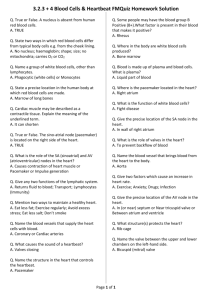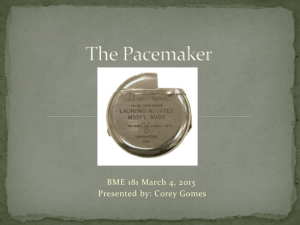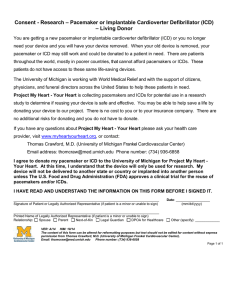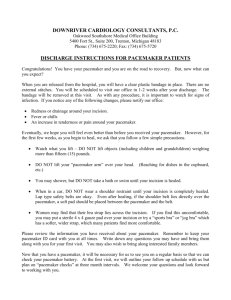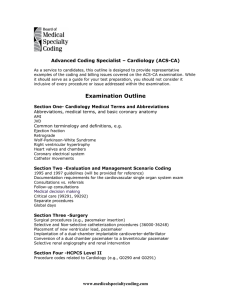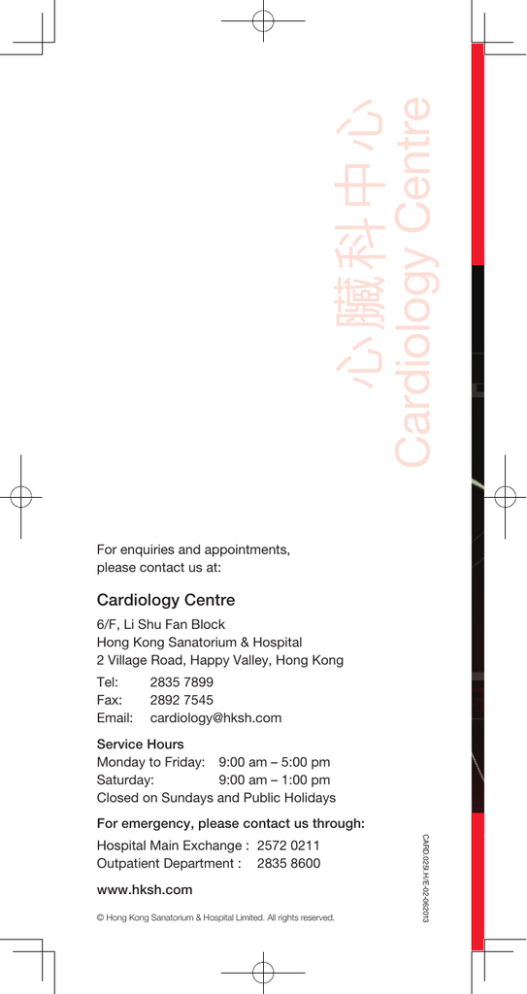
Cardiology Centre
心臟科中心
For enquiries and appointments,
please contact us at:
Cardiology Centre
6/F, Li Shu Fan Block
Hong Kong Sanatorium & Hospital
2 Village Road, Happy Valley, Hong Kong
Tel: 2835 7899
Fax: 2892 7545
Email: cardiology@hksh.com
Service Hours
Monday to Friday: 9:00 am – 5:00 pm
Saturday: 9:00 am – 1:00 pm
Closed on Sundays and Public Holidays
For emergency, please contact us through:
www.hksh.com
© Hong Kong Sanatorium & Hospital Limited. All rights reserved.
CARD.025I.H/E-02-062013
Hospital Main Exchange : 2572 0211
Outpatient Department : 2835 8600
Im
Pacemaker /
Implantable Cardiovertor
Defibrillator (ICD)
心臟科中心
Cardiology Centre
Pacemaker / Implantable
Cardiovertor Defibrillator (ICD)
The human heart is an important organ that pumps
blood throughout the body. The heart normally beats 60
to 100 times per minute at a resting rate. During exercise
or emotional stress, the body requires more oxygen and
the heart beats faster at over 100 times per minute.
What Is Cardiac Arrhythmia?
Arrhythmia is any disorder of your heart rate or
heart rhythm, such as beating too fast, too slow, or
irregularly, which affects blood supply to the body.
Arrhythmia may be caused by hereditary factors, ageing
or disease. Common arrhythmias are the heart beating
too fast (tachycardia) or too slow (bradycardia). Some
types of arrhythmia cause dizziness, feebleness and
fatigue, which in serious cases may lead to coma or
death.
Two Common Types
of Arrhythmia
Bradycardia
1.Sick Sinus Syndrome (SSS)
The sinoatrial node (SA node) is located in the muscle
area of the right atrium. It is the body's natural
pacemaker, generating impulses that cause the heart
to contract. Patients with SSS have a defective SA
node, causing sinoatrial block, where some impulses
generated fail to leave the node, or sinus arrest,
where there are long pauses between the generation
of impulses. As a result, the heart fails to beat as fast
as the body requires.
2.Heart Block
The atrioventricular node (AV node) is located in the
muscle area between the right atrium and the right
ventricle. It transmits impulses from the SA node to
the ventricle and the rest of the heart. Patients with
Heart Block have a defective AV node, in which case
some or all impulses fail to leave the AV node, thus
blocking transmission between the atria and the
ventricles.
The artificial pacemaker is a form of treatment for
bradycardia in the above situations.
Functions of Pacemaker
The basic functions of pacemaker are to monitor heart
rhythm and control heartbeat. When the heart beats
abnormally or irregularly, the pacemaker generates
pre-determined impulses to stimulate the heart to beat
regularly.
The pacemaker has two basic parts:
Pacemaker:
A metal case which contains a battery and a circuit for
monitoring the heartbeat and producing impulses.
Pacing Lead:
It is an extremely flexible insulated wire which makes
contact with the heart through a metal electrode at the
lead tip. It helps monitor the heart’s electrical activity
and transmits electrical impulses to the heart from the
pacemaker.
Types of Pacemakers
Single-Chamber Pacemaker
A single-chamber pacemaker has only one pacing
lead to be placed into a chamber of the heart, either
the right atrium or the right ventricle. It is mainly for
patients with problems in either the sinoatrial node or
the atrioventricular node.
Dual-Chamber Pacemaker
A dual-chamber pacemaker has two pacing leads to
be placed in two chambers of the heart, usually the
right atrium and the right ventricle. It is mainly used
for patients with atrioventricular dissociation (lack of
coordination between the atrium and the ventricle).
Biventricular Pacemaker
A biventricular pacemaker has three pacing leads
connected to the right atrium, the right ventricle,
and the coronary sinus, which pace the left
ventricle respectively. It can also provide cardiac
resynchronisation therapy (CRT) for patients with
heart failure.
Tachycardia
In some instances, tachycardia can be fatal if an
episode of extremely fast and irregular ventricular
arrhythmia continues for a period of time without
treatment.
1.Ventricular Tachycardia (VT)
When the heart's conduction system malfunctions,
electrical signals arrive at the ventricle too soon
or lead to a "short circuit", causing Ventricular
Tachycardia common in patients with a history of
Myocardial Infarction. As the heart beats faster,
there is not enough time for the heart to fill with
blood between beats, which decreases the heart's
efficiency of pumping blood to the rest of the body.
Within a short time, the brain and the body may be
deprived of oxygen. The patient may feel that the
heart is skipping beats and may lose consciousness.
Without proper treatment, VT can be fatal.
2.Ventricular Fibrillation (VF)
In Ventricular Fibrillation, electrical signals originate
from many different locations in the ventricles, each one
trying to give signals to the heart to beat. As a result,
the heart beats much faster than normal, sometimes
over 300 beats a minute. The ventricles quiver instead
of actually contract, and very little, if any, blood is
pumped from the heart to the rest of the body. If one's
heart is in VF, one becomes unconscious very quickly.
If these irregular, fast heart rhythms continue for a
length of time, the body will not get enough oxygencarrying blood. Without oxygen, the brain and body
tissues cannot function normally and may even die.
Functions of Implantable
Cardiovertor Defibrillator (ICD)
ICD is a pacemaker-like device that continuously
monitors the heart rhythm, and delivers life-saving
shocks if a dangerous heart rhythm is detected. It
can significantly improve survival rate of patients with
ventricular fibrillation, which is the primary cause of
sudden cardiac death. ICDs also have the ability to
act as a pacemaker for those with slow heart rate, and
can be modified to provide resynchronisation therapy.
Different pacemakers serve different purposes. Your
doctor will provide a detailed explanation and choose
the best option for you.
Implantation of Pacemaker/ICD
How the Pacemaker/ICD Is Implanted
While the procedure usually takes 2 hours, the
implantation of biventricular pacemaker and ICD may
take longer. No general anaesthesia is needed; patients
are conscious throughout the procedure.
1.Local anaesthesia is performed under the left or
right collarbone. A small incision is made and a little
“pocket” is created
2.Insert a pacing lead through a vein and into the heart
3.Use X-ray to monitor if the lead is in correct position
and working
4.Place the lead firmly into position and connect it to
the pacemaker
5.Insert the pacemaker into the “pocket” and suture
the wound
Pre-Operative Preparation
1.Most patients are to be admitted to the hospital
one day before their operation to undergo basic
investigation, including ECG, blood test, chest X-Ray,
etc.
2.Stop medication as instructed by your doctor
3.Notify your doctor and all healthcare personnel about
your drug or food allergies
4.Refrain from eating or drinking 6 to 8 hours before
the operation
5.Sign the consent form
6.If necessary, a mild sedative may be prescribed
before the operation
7.A venous catheter is inserted into the forearm
Post-Operative Care
1.Limit upper limb movement on the operated side to
help with wound healing
2.Inform your doctor immediately if you experience any
of the following symptoms:
--Difficulty in breathing, dizziness or fainting
--Swelling over your wrist and ankle
--Chest pain or hiccups
--Redness over incision site with bloody discharge
Going Home
Patients can resume normal activities shortly after
implantation. Discuss with your doctor prior to resuming
your hobbies, sports and/or sexual activities.
1.Take the prescribed medication as instructed
2.Attend follow-up appointments regularly
3.Carry your pacemaker/ICD identification card with
you all the time
4.Contact your doctor if you notice anything strange
with your pacemaker
5.Take note of your surroundings and the devices that
may interfere with your pacemaker, such as power
generating equipment, powerful magnets, etc.
6.Discuss the possible risks and benefits with your
doctor before you undergo any medical/diagnostic
procedures such as MRI, lithotripsy, radiofrequency
ablation, transcutaneous electrical nerve stimulation
(TENS), dental drilling or diathermy usage
7.I f y o u e x p e r i e n c e a n y s y m p t o m s , s u c h a s
dizziness, irregular pulse or rapid heartbeat while
approaching certain electrical devices, stay away
from them and/or turn them off immediately.
Consult your doctor for further advice

